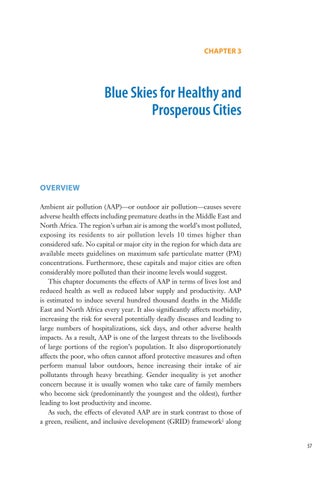CHAPTER 3
Blue Skies for Healthy and Prosperous Cities
OVERVIEW Ambient air pollution (AAP)—or outdoor air pollution—causes severe adverse health effects including premature deaths in the Middle East and North Africa. The region’s urban air is among the world’s most polluted, exposing its residents to air pollution levels 10 times higher than considered safe. No capital or major city in the region for which data are available meets guidelines on maximum safe particulate matter (PM) concentrations. Furthermore, these capitals and major cities are often considerably more polluted than their income levels would suggest. This chapter documents the effects of AAP in terms of lives lost and reduced health as well as reduced labor supply and productivity. AAP is estimated to induce several hundred thousand deaths in the Middle East and North Africa every year. It also significantly affects morbidity, increasing the risk for several potentially deadly diseases and leading to large numbers of hospitalizations, sick days, and other adverse health impacts. As a result, AAP is one of the largest threats to the livelihoods of large portions of the region’s population. It also disproportionately affects the poor, who often cannot afford protective measures and often perform manual labor outdoors, hence increasing their intake of air pollutants through heavy breathing. Gender inequality is yet another concern because it is usually women who take care of family members who become sick (predominantly the youngest and the oldest), further leading to lost productivity and income. As such, the effects of elevated AAP are in stark contrast to those of a green, resilient, and inclusive development (GRID) framework1 along
57






